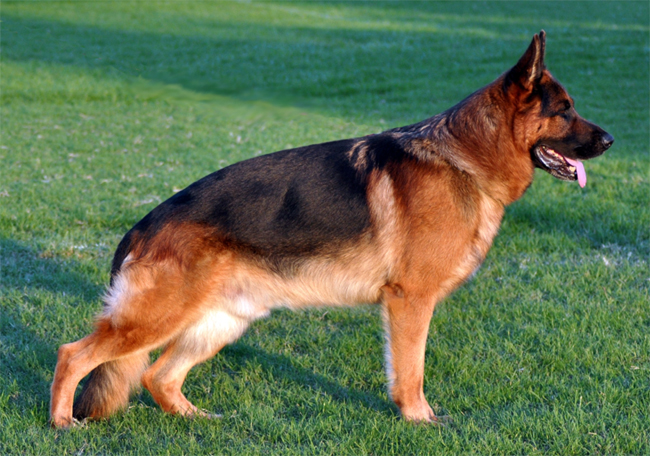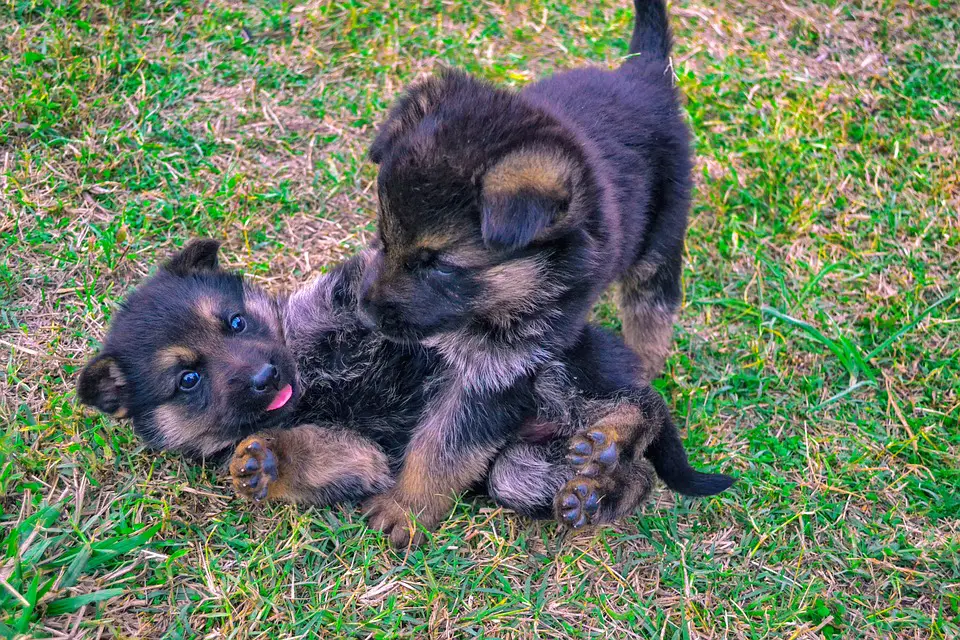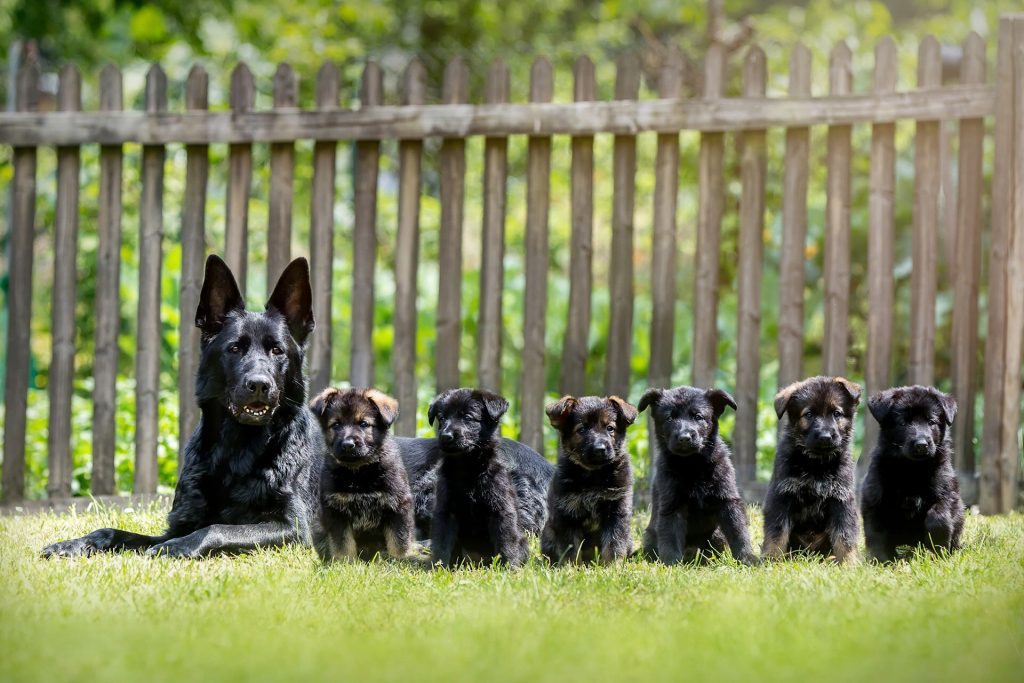German shepherd puppy training, bringing a new German Shepherd puppy home is an exciting time, however, among all this emotion we must not forget the most important thing, the training of your German shepherd puppy.
German shepherd puppy training
Before delving into some tips for training a German shepherd puppy, you should first read some tips on adopting a new puppy:
- The adoption of any new pet is a great responsibility and commitment. Therefore, it is necessary that you take a long and careful look before selecting your new German shepherd puppy. If you decide that it is the right time to bring a new puppy to your home, then the fun can start with the selection of your new and spectacular German shepherd.
- It is important that you make sure that you adopt your German shepherd puppy from a known and reputable breeder. Ask your breeder for references and proof that your German shepherd puppy was raised in a healthy way. If the breeder can not provide you with this information, then it may be better to adopt from another person.
- You can be predisposed to choose the most excitable and bravest puppy in the litter. This is not exactly a bad thing, however, it is important to remember that this small bundle of joy can become the most difficult to train. So, take your time choosing your German shepherd puppy, instead of rushing.
German shepherd puppy training tips
Training advice Once you have chosen and taken your new German shepherd puppy home, the fun can begin; the training of your puppy. The following are some useful tips to help you do it:
- It is best to start training your German shepherd puppy the moment you bring it home. If you do this, then your German shepherd must remember the lessons and he will behave well for life.
- It is vital that you show your German shepherd that you are the alpha leader of your family the moment you bring him home. If you do this, then your German shepherd will be more likely to listen to you during the training process. If you do not establish this position, then your German pastor may try to become the alpha leader, which in turn can lead to disobedient behavior.
- Use rewards to encourage your German shepherd. A good reward you can use is praise and affection, however, a dog treat will be fine too.
- When your German pastor reaches old enough, you can teach him to go to the bathroom. The best way to deal with your dog’s sphincter control is to have a set schedule. This means taking them to the designated place at fixed times during the day. Could be.
- When they wake up or after they have eaten. Also, use rewards when your puppy does it correctly, as this encourages them. Remember that your German shepherd is only a small puppy and there will be some accidents, if there are accidents it is vital that you do not get mad at your puppy, this can scare them and it will only prolong the learning process.
- Teaching him the basic commands is another important aspect in the training of a German Shepherd puppy that can start from the beginning. These basic commands include sitting down and still. To teach your dog commands, you will need to repeat them daily. The more you repeat them, the more your German shepherd will understand them. And again, use rewards such as affection or treats when your German shepherd does it correctly.
- As your German Shepherd puppy grows older and wiser, you can teach them more complicated things. However, in the puppy stage, it is best to start in a simple way.
Training your German shepherd puppy may seem difficult, but it does not have to be. As long as you spend time and be patient, your German shepherd must end up being a well trained and obedient dog. So, do not wait any longer, start training your German shepherd puppy today.
GSD puppy training
How to train a German shepherd puppy? Do we have to apply the same training method for all dogs? Do not! The German Shepherd is one of the most popular and loved breeds in the world, but the truth is that it can have a particular and strong character, so it is necessary to give a firm and specific education to make it an emotionally stable animal and sociable in the future. We tell you how to achieve it!
How do I make sure my dog does not pull on the leash?
Before you got home, you imagined long and pleasant walks with your pet, however, you find that going out on the street means getting exhausted by the constant pulls to avoid running after it.
Most dogs do not walk naturally, but they must be educated for that. You also have to understand that when a dog is excited about an exciting activity like going out, it is normal to want to run, so you should not take it as bad behavior but patiently teach that you want something else from him.
Training tips before going outside
- Before leaving it is convenient to play with him actively inside the house for a long time, so when the time comes to leave he is a little more tired and less anxious. For that, it is great to throw a ball or a toy and make him run to reach it several times.
- Then comes the time to put the strap; If your dog starts to jump and bark, stay still and quiet until you have calmed down. It is important that you understand that you must be still, so when you leave your mind you will be more relaxed. Repeat this as many times as necessary before hooking the strap and opening the door.
Once on the street, there are different methods to control the dog, according to its size and behavior. The idea is to teach him with prizes. Take some treats with you to go every 3 or 4 steps while walking beside you. They have to be soft and small bites, easy to swallow. This will make the dog pay attention only to you, instead of looking around.
- Do not forget to congratulate him and give him a caress. After repeating the lesson successfully for several days, begin to space the candy and replace it with words and caresses until you get used to walking alongside.
- Another form of training for dogs that have already learned the basic commands is to start walking and each time the dog gets ahead and starts pulling on the leash, you stop abruptly and make him sit down. Once you are calm you start to walk again and repeat if you go ahead again.
- If the ride goes more or less well, instead of sitting down when you pull you can give a sharp but brief pull (something that does not hurt) with the strap and you say NO. When I return to your side, congratulate and continue. With this, the dog learns that every time he pulls you force him to stop in some way and he takes longer to get where he wanted. Remember that it is much more effective to give short pulls than to pull constantly because the dog gets used to walking like this and pulls harder.
- It is important that you walk with good pace because if you go too slow at this stage of learning it will be very difficult for the dog to stop to follow you.
What do I need to educate my dog not pull on the leash?
First, the strap must be resistant, according to the strength of your dog, and no more than 2 meters. When you have learned you can use a longer or extensible, but you can not have good control of your pet during training if you use one of these models.
You should also carry a sweets kit; A practical accessory although not essential is the bag to keep it hanging at the waist.
The necklace can be simple nylon with buckle. To have better handling of the animal the collar should go very high, just behind the neck, but it does not need to be too tight, so your dog will walk comfortably. For “indomitable” dogs or impatient people, there is the Easy Walk front-grip driving harness, which is designed to prevent dogs from pulling. This system works very well, but you should also educate your dog to ensure that you can also control it with a common collar.
Basic obedience to train your dog
A dog can be trained and educated at any time in his life, but it is true that if you have a puppy, the thing is much simpler. All dogs that are not well educated tend to develop behavioral problems in the future; In the case of the German shepherd, the most typical are fears, possessiveness and the excessive instinct of territoriality. With proper training, we will be able to educate our German shepherd to prevent the appearance of these behavioral problems.
To train a German shepherd puppy, one of the things you should keep in mind is your socialization. To have complete socialization, dogs need to know how to relate to everything in their environment, and this includes:
- Adults
- Children
- Dogs and other animals, both those on the street and if you have more pets at home
- Inert elements of your environment, such as means of transport
- Sounds, lights and other stimuli around him
In order to give your dog good socialization, it is essential that your first contact with all these individuals and elements be positive, that you get a good impression of them, free of frights, tensions, and fears. The walks and other activities abroad are an important part of the process of socialization of a dog, it is the opportunity they have to know everything around them. Also, at the same time, you must teach him to do his needs outside the home.

Teach your dog – adult German shepherd
If you have just adopted an adult German shepherd and you have not been educated before, you have behavior problems, fears or traumas, do not worry! With dedication and patience, it can be arranged. In dog education, nothing is impossible. Of course, it is true that it is somewhat more complicated to educate an adult than a puppy since the former already have bad behaviors well acquired and customs that are somewhat complex to overcome. But it can!
Even if your dog is an adult, if you have no notions of canine education, you should start with the basics, just as you would with a puppy. You must teach him to sit, lie down, react to his name and come when he is called, to sit still, walk by your side … The fundamental orders to communicate and live with him, which will later give rise to learn more complex orders.
It is very important that you always use positive reinforcement to train a dog, whether it is a puppy or an adult. It is the best way to get them to perceive the training as something positive and to be motivated to continue learning. Also, you should not saturate your pet either; for an adult, 15 minutes of daily training is enough. If you extend too much time, you will get tired, distract and lose interest.
The importance of exercise to train German shepherd dog puppy
If you want to know how to train a puppy, it is not only important to know the basic behavior lessons, but also to take care of your dog at all times. The welfare of pets greatly influences their behavior. To avoid the accumulation of energy and stress that can turn into aggressiveness, your dog needs to spend that energy every day doing exercise.
German shepherds are especially active, they are often used as police and rescue dogs! They have a lot of energy to spend, so it will be necessary for your dog to exercise several times every day. With a German shepherd, it is not enough to go out for relaxed walks, just enough to pee and go back home; You need to really exercise. The best thing is to find a place where you can release it safely so that it runs and plays at ease for a while. You can take a toy to throw, go to the field, play sports with him … There are many ways to exercise and have fun!
If you just adopted one, it’s great that you want to know how to train a puppy! Doing it the right way will help your dog develop a peaceful, stable and sociable character. Well-being and happiness for everyone, including your dog!

Obedience training – Training your German shepherd puppy to sit down
Sitting is usually one of the first commands taught to German Shepherd puppies. The sit command is beneficial and can even be used to calm an altered puppy before receiving his feed ration, as well as other essential times throughout the day.
To train your German shepherd puppy how to sit, follow the following tips:
- First, grab a handful of dog treats and keep them hidden in one of your hands.
- Find a quiet place at home or in the garden that does not have any distractions so that your puppy can concentrate on you and the training session.
- Stand in front of your puppy so he can see your face and yours.
- Place a treat in your hand that you plan to use to make the signal. Allow the puppy to smell its possible reward through your hand, but do not let it eat it yet. This will attract your attention.
- Place the candy on your fingertips so your puppy can see it and hold it directly above your nose at a high level.
- While you move your arm forward with the candy in your hand, say that the verbal command used to tell you to sit down (many trainers use the English word “sit”). The idea is that your puppy to follow the candy makes a natural movement that leads him to sit.
Once your puppy sits down, give him the prize as a reward and show him compliments by caressing him and telling him that he has done a good job.
Continue repeating this procedure until your puppy follows the commands without errors. During the training process, you must control the amount of candy that the puppy gets to ingest. Otherwise, if you eat a lot of treats at once can cause your dog to have digestive problems or make you gain weight. As you go through the training, you can replace the treats with verbal and emotional praises accompanied by a gentle pat on the head.

Obedience training – Training your German shepherd not to jump
Being greeted at the door of your house with the enthusiasm and excitement that a pet can present as a German shepherd can be a big ego for its owner but it can also be a problem if the dog gets you jumping and jumping.
Your cute German shepherd puppy will grow into an adult dog very quickly, so jumping can easily knock you down and hurt you when in reality it just wanted to welcome you.
Obedience training – How to teach your German Shepherd not to bite you
German shepherd puppies are playful and full of energy. The way they played with the other members of their litter when they were with their mother is the same way they want to play with you and your family.
Playing is a natural skill for German Shepherd puppies that do not require training. These are the moments when you are sitting quietly on the couch or on the floor, and your puppy jumps on you and tries to nibble on your fingers, toes, and sometimes your clothes.
They are playing but it is up to you to set the limits, as your canine mother would do and she did it when your puppy was still with her. It is up to you to establish your own limits.
- While playing with your puppy, have fun and enjoy. It is one of the best ways to bond with him, and it is a connection that will last your entire life.
- Once your puppy begins to nibble and bite, make a sudden movement, scream and quickly pull your hand, feet, legs, clothes or any part that your puppy has just nibbled.
- Pause and count to ten in your head.
- Then play again with your puppy. If the situation repeats, repeat the steps.
This may sound too easy, but it works.
You just have to stay calm and over time your puppy will learn exactly what strength and pressure is the right amount to use during game time. Soon he will only bite you gently to play. If you prefer that the dog does not even nibble, just continue the training tips until there are no bites.
A great help is to replace your fingers and toes with one of your favorite toys. Introducing her toys, you are guiding her to chew on the objects you approve of her nibbling, so in the end, she will only bite her toys.

Positive reinforcement – How to train a German Shepherd to come to call him
There will be times when you will call your puppy to come to you for a variety of reasons. These reasons include eating, drinking, going out to the garden, taking a walk, knowing where he is, not wanting him to go anywhere, call him in the park, etc.
Train your puppy to come by calling him following the steps listed below:
- First, fill one of your hands with small treats.
- Go outdoors in your patio or where there is open space, but at the same time, it is a fenced area. If you live in an apartment, you can use a room.
- Keep both arms straight so that your body resembles a cross-like figure.
- At the same time, you hold your arms, say the verbal command “come.” (or “eat”).
- When your dog reaches your feet, quickly give him a treat and reward him verbally or gently stroking him on the head.
- Repeat the process until your puppy understands what their appropriate reaction should be.
The reason why you use a signal with your arms open for this specific command is that if your dog is away from you in a park or on the street, he may not be able to hear you. But you will most likely be able to see your gesture with your arms from a distant distance.
Positive reinforcement – Train your dog to not bark if it is not necessary
German shepherds are great guard dogs, so you do not want to train them against this good instinct.
It’s your natural instinct, and it’s the way you show your loyalty to your family. However, if your German shepherd puppy barks constantly for no reason, this is a time when you will want to teach him not to bark.
- First, you must find out if there is someone or something that is causing your barking. Sometimes even a curtain that flows in the wind can trigger a barking session. Remove all these stimuli or objects that move and cause their barking.
- Then, allow your puppy to “befriend” the stimulus and object if it can not be removed. Place a reward near the object and encourage your puppy with a soft tone to reach the candy. Repeat this until your puppy becomes familiar with the object and no longer cares about it and only focuses on the treatment.
If your puppy continues to bark continuously, it is advisable to visit the veterinarian for a checkup and to rule out any health problems.
And as always if you liked what you read here and want to read more check out my other articles on Do Dogs Teeth Grow Back?



